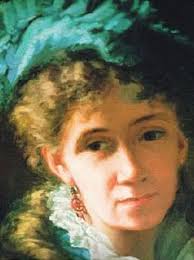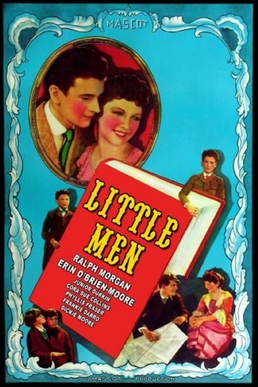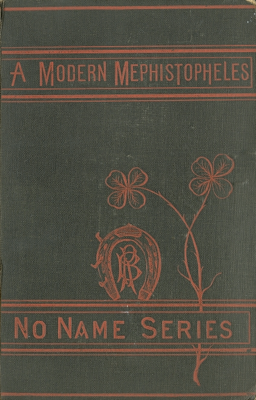
Louisa May Alcott was an American novelist, short story writer, and poet best known for writing the novel Little Women (1868) and its sequels Good Wives (1869), Little Men (1871) and Jo's Boys (1886). Raised in New England by her transcendentalist parents, Abigail May and Amos Bronson Alcott, she grew up among many well-known intellectuals of the day, including Margaret Fuller, Ralph Waldo Emerson, Nathaniel Hawthorne, Henry David Thoreau, and Henry Wadsworth Longfellow.

Little Women is a coming-of-age novel written by American novelist Louisa May Alcott, originally published in two volumes in 1868 and 1869. The story follows the lives of the four March sisters—Meg, Jo, Beth, and Amy—and details their passage from childhood to womanhood. Loosely based on the lives of the author and her three sisters, it is classified as an autobiographical or semi-autobiographical novel.

Abigail May Alcott Nieriker was an American artist and the youngest sister of Louisa May Alcott. She was the basis for the character Amy in her sister's semi-autobiographical novel Little Women (1868). She was named after her mother, Abigail May, and first called Abba, then Abby, and finally May, which she asked to be called in November 1863 when in her twenties.

Little Women is a 1994 American coming-of-age historical drama film directed by Gillian Armstrong. The screenplay by Robin Swicord is based on Louisa May Alcott's 1868–69 two-volume novel of the same title, the fifth feature film adaptation of the classic story. After a limited release on December 25, 1994, it was released nationwide four days later by Columbia Pictures.

Little Men, or Life at Plumfield with Jo's Boys, is a children's novel by American author Louisa May Alcott (1832–1888), which was first published in 1871 by Roberts Brothers. The book reprises characters from her 1868–69 two-volume novel Little Women, and acts as a sequel, or as the second book in an unofficial Little Women trilogy. The trilogy ends with Alcott's 1886 novel Jo's Boys, and How They Turned Out: A Sequel to "Little Men". Alcott's story recounts the life of Jo Bhaer, her husband, and the various children at Plumfield Estate School. Alcott's classic novel has been adapted to a 1934 film, a 1940 film, a 1998 film, a television series, and a Japanese animated television series.

Little Women is a 1949 American comedy-drama film with script and music taken directly from the earlier 1933 Hepburn version. Based on Louisa May Alcott's 1868–69 two-volume novel of the same name, it was filmed in Technicolor and was produced and directed by Mervyn LeRoy. The screenplay was written by Sally Benson, Victor Heerman, Sarah Y. Mason, and Andrew Solt. The original music score was composed by Adolph Deutsch and Max Steiner. The film also marked the American film debut of Italian actor Rossano Brazzi. Sir C. Aubrey Smith, whose acting career had spanned four decades, died in 1948; Little Women was his final film.

An Old-Fashioned Girl is a novel by Louisa May Alcott first published in 1869, which follows the adventures of Polly Milton, a young country girl, who is visiting her wealthy city friends, the Shaws. The novel shows how Polly remains true to herself despite the pressure the Shaws' world puts on her shoulders.

Eight Cousins, or The Aunt-Hill was published in 1875 by American novelist Louisa May Alcott. It was originally published as a serial in St. Nicholas. It is the story of Rose Campbell, who has been recently orphaned and resides with her maiden great aunts, the matriarchs of her wealthy family near Boston, until her guardian, Uncle Alec, returns from abroad to take over her care. Through his unorthodox theories about child-rearing, she becomes happier and healthier while finding her place in her family of seven boy cousins and numerous aunts and uncles. She also makes friends with Phebe, her aunts' young housemaid, whose cheerful attitude in the face of poverty helps Rose to understand and value her own good fortune.

Little Women II: Jo's Boys, also known as Wakakusa Monogatari Nan to Jō Sensei is a 1993 Japanese animated television series based on Louisa May Alcott's Little Men, produced by Nippon Animation. The title is taken from Jo's Boys, the title of the sequel to Little Men, on which the series is also partially based.
Little Men is a Canadian television show that first aired on November 7, 1998 on the PAX TV network and was shown in Canada on CTV beginning January 1, 1999. The show is set as a continuation of the Louisa May Alcott novel Little Men (1871), a follow-up to Little Women (1868). Due to low ratings, the show was cancelled after 2 seasons, with the final episode aired on December 17, 1999.

Little Women is a musical with a book by Allan Knee, lyrics by Mindi Dickstein, and music by Jason Howland.

A Long Fatal Love Chase is a 1866 novel by Louisa May Alcott published posthumously in 1995. Two years before the publication of Little Women, Alcott uncharacteristically experimented with the style of the thriller and submitted the result, A Long Fatal Love Chase, to her publisher. The manuscript was rejected, and it remained unpublished before being bought, restored and published to acclaim in 1995.

Under the Lilacs is a children's novel by Louisa May Alcott, first published as a serialized story in St. Nicholas magazine in 1877-1878. It was first published in book form by Roberts Brothers in 1878. The plot follows twelve-year-old Ben Brown, a circus runaway who makes friends with the Moss family. He also becomes friends with Miss Celia and her brother Thornton, and Miss Celia eventually allows Ben to live at her house.

Little Men (1940) is an American film based on the novel Little Men (1871) by Louisa May Alcott. Norman Z. McLeod directed the film. It is the second sequel to Little Women after Little Men
Behind a Mask, or A Woman's Power is a novella written by American author Louisa May Alcott. The novella was originally published in 1866 under the pseudonym of A. M. Barnard in The Flag of Our Union. Set in Victorian era Britain, the story follows Jean Muir, the deceitful governess of the wealthy Coventry family. With expert manipulation, Jean Muir obtains the love, respect, and eventually the fortune of the Coventry family.

Little Men is a 1934 American feature film based on Louisa May Alcott's 1871 novel Little Men, starring Ralph Morgan and Erin O'Brien-Moore, directed by Phil Rosen, and was released by Mascot Pictures. It is a sequel to Little Women

Little Women is a lost 1918 American silent drama film directed by Harley Knoles and written by Anne Maxwell based upon the 1868-69 two-volume novel of the same name by Louisa May Alcott. The film stars Isabel Lamon, Dorothy Bernard, Lillian Hall, Florence Flinn, and Conrad Nagel. The film was released on November 10, 1918, by Paramount Pictures.
Little Men is a 1998 Canadian family drama film starring Mariel Hemingway and Chris Sarandon. It is based on the 1871 novel of the same name written by Louisa May Alcott, the author of Little Women. It is a loose sequel to Little Women (1994).

Little Women is a play in four acts by Marian de Forest which was adapted from the novel of the same name by Louisa May Alcott. The only full-length stage adaptation of the work authorized by the Alcott family, the work was first staged on Broadway at the Playhouse Theatre in 1912. It was subsequently revived on Broadway in 1917, 1931, 1944, and 1946. The play was frequently performed in regional theatre in the United States during the early to mid 20th century.

A Modern Mephistopheles is a gothic thriller published by the Roberts Brothers in 1877 and written by Louisa May Alcott. It is based on Goethe's Faust and contains stylistic elements Alcott used earlier in her writing career. The novel follows Felix Canaris and Gladys, two young people whose lives are manipulated by a wealthy semi-invalid Jasper Helwyze, who seeks to undermine their relationship for psychological experimentation. Under Helwyze's direction, Canaris and Gladys marry. Gladys and Canaris eventually overcome Helwyze's influence on them.


















